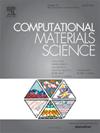The atomic formation mechanism of GP zones in Al-Cu alloys: Insights from cluster expansion coupled with Monte Carlo simulation
IF 3.1
3区 材料科学
Q2 MATERIALS SCIENCE, MULTIDISCIPLINARY
引用次数: 0
Abstract
Guinier-Preston (GP) zones in Al-Cu alloys are noted for their precipitation-hardening effects and their critical role in elucidating the nanoscale organization of solute atoms. In this study, we employed the cluster expansion (CE) method combined with Monte Carlo (MC) simulations to investigate the formation and evolution of GP zones in Al-Cu alloys, particularly in the presence of vacancies and Mg. The CE model was trained on energies calculated by first-principles density functional theory (DFT), enabling subsequent MC simulations to explore clustering behavior of matrix-coherent Cu-rich structures. The simulations reproduced the formation of GPⅠ and GPⅡ zones, demonstrating that the model can capture atomic interactions responsible for Cu clustering. Crucially, the presence of vacancies promotes GP zone formation and facilitates the transition from GPⅠ to GPⅡ zones. Furthermore, Mg addition to Al-Cu alloys reduces the size of Cu-rich clusters while increasing shape diversity, and when combined with vacancies, leads to more complex structures consistent with experimentally observed Guinier-Preston-Bagaryatsky (GPB) zones. Subsequently, we studied GP zone decomposition during heating as a function of Cu concentration, revealing significantly improved agreement with experimental data compared to prior computational studies. These findings not only provide atomic-scale insights into GP zone formation mechanisms and the roles of vacancies and Mg, but also demonstrate the effectiveness of combining CE and MC approaches for studying nanoscale precipitation processes in Al-Cu and Al-Cu-Mg alloys.

求助全文
约1分钟内获得全文
求助全文
来源期刊

Computational Materials Science
工程技术-材料科学:综合
CiteScore
6.50
自引率
6.10%
发文量
665
审稿时长
26 days
期刊介绍:
The goal of Computational Materials Science is to report on results that provide new or unique insights into, or significantly expand our understanding of, the properties of materials or phenomena associated with their design, synthesis, processing, characterization, and utilization. To be relevant to the journal, the results should be applied or applicable to specific material systems that are discussed within the submission.
 求助内容:
求助内容: 应助结果提醒方式:
应助结果提醒方式:


